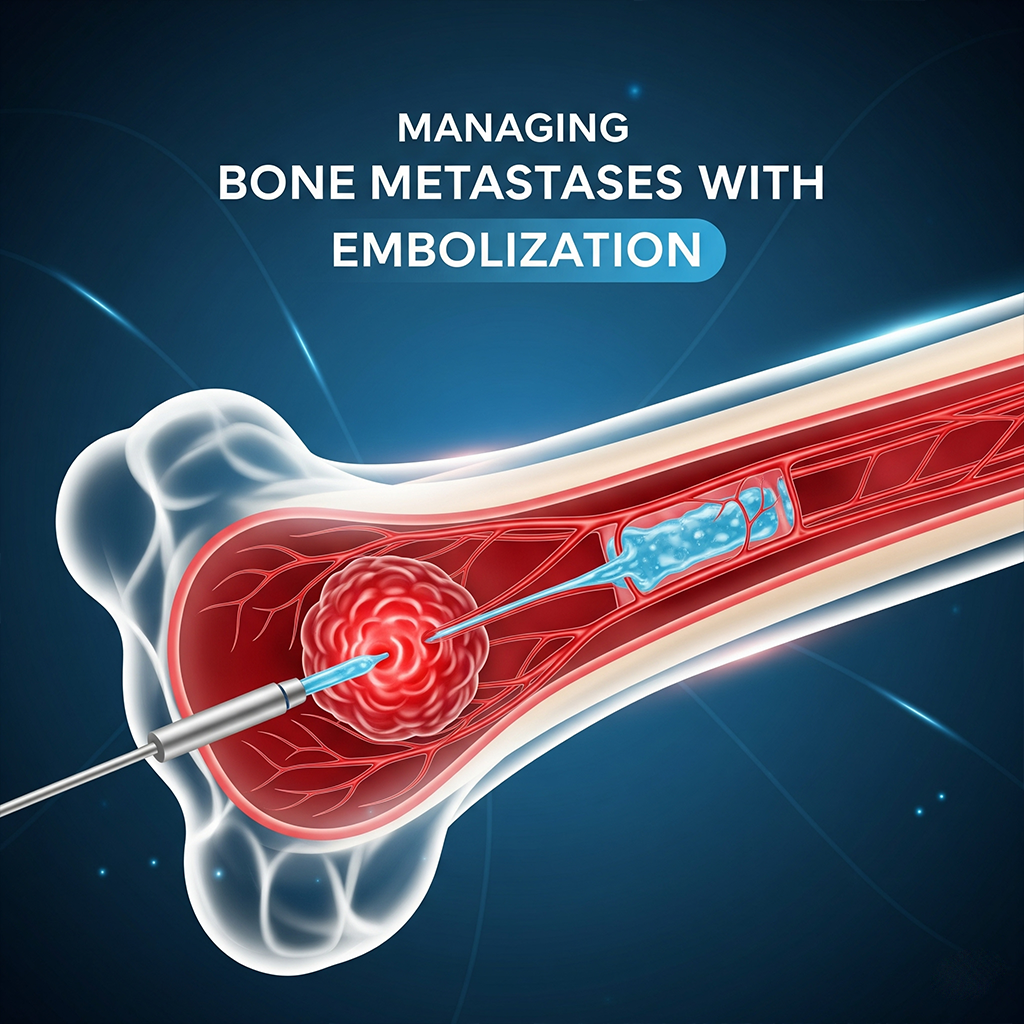A Breakthrough Non-Surgical Solution Offering Hope in Interventional Radiology
When cancer spreads to the bones, it often causes severe pain, fractures, and difficulty in movement. This stage is known as bone metastases. While surgery, radiation, and medications are common treatments, a newer option — embolization — is proving to be highly effective in easing pain and improving quality of life.
In this blog, we’ll explain what bone metastases are, how embolization works, and why it is becoming an important treatment choice for many patients.
What Are Bone Metastases?
Bone metastases occur when cancer from another organ (like breast, lung, kidney, or prostate) spreads to the bones. This can make the bones weak, painful, and prone to fractures.
Common symptoms include:
- Constant or severe bone pain
- Swelling around affected bones
- Increased risk of fractures
- Back pain due to spinal cord pressure
- Difficulty walking or performing daily activities
According to Dr. Vrishit Saraswat, expert in interventional oncology, early treatment is key to reducing complications and improving patient comfort.
Conventional Treatment Options
The current treatments for bone metastases include:
- Radiation therapy – helpful but may not work for all tumor types
- Surgery – used in cases of fractures or spinal cord compression, but involves longer recovery
- Systemic therapies – chemotherapy, hormone therapy, or targeted therapy that slow cancer spread
While effective, these treatments may not fully control pain or prevent further damage. This is where embolization can make a difference

What Is Embolization for Bone Metastases?
Embolization is a minimally invasive treatment performed by an interventional radiologist. The procedure involves:
- Inserting a thin catheter into a blood vessel (through the groin or wrist).
- Guiding it to the arteries supplying the tumor.
- Injecting special particles to block blood flow to the tumor.
By cutting off the tumor’s blood supply, embolization helps in:
- Reducing pain
- Preventing fractures
- Controlling bleeding in affected bones
You can learn more about advanced interventional procedures
Benefits of Embolization
Compared to conventional treatments, embolization offers unique advantages:
- Significant pain relief in patients not responding to medications
- Helps prevent fractures by reducing tumor burden
- Controls bleeding in bone tumors
- Minimally invasive — no large cuts or long hospital stays
- Short recovery period — patients often resume activities within days
- Can be combined with radiation or systemic therapy for better results
Who Can Benefit from This Treatment?
Treatment | Limitations | Role of Embolization |
Radiation | Tumors may resist radiation | Works even in radiation-resistant tumors |
Surgery | Invasive, longer recovery | Quick recovery, less invasive |
Medications | Pain may persist | Directly reduces pain by cutting blood supply |
Recovery After Embolization
- Most patients stay overnight for observation.
- Pain relief is usually noticed within a few days.
- Patients can resume normal activities quickly.
- The procedure is safe, with very few complications.
Supportive Role in Advanced Cancer
For patients with advanced cancer, the aim is often comfort and quality of life rather than cure. Embolization fits perfectly as a palliative option, reducing pain, bleeding, and complications.
At Dr. Vrishit Saraswat’s center, embolization is part of a multidisciplinary care plan designed to give patients the best possible outcomes.
Looking Ahead: The Future of Embolization
With ongoing research, embolization is now being combined with:
- Immunotherapy
- Targeted therapy
- Advanced radiation techniques
This combination approach is expected to further improve results for patients with bone metastases.
Conclusion
Bone metastases can be overwhelming, but modern treatments like embolization bring hope. By relieving pain, controlling bleeding, and preventing fractures, this minimally invasive procedure helps patients live better with advanced cancer.
If you or a loved one is facing bone metastases, consult Dr. Vrishit Saraswat to know whether embolization is the right treatment option.
FAQs
We understand that patients and families often have many questions about oncological interventions. To help you, we’ve compiled answers to the most frequently asked questions. If your query isn’t listed here, please feel free to reach out to us directly.
Q1. Is embolization safe for bone cancer patients?
Yes, embolization is considered very safe when performed by a trained interventional radiologist.
How long does pain relief last?
Relief can last several months, and the procedure can be repeated if required.
Q3. Can embolization cure bone metastases?
No, embolization does not cure cancer, but it controls symptoms and improves quality of life.
Q4. What is the recovery time after embolization?
Most patients resume normal activities within a few days.
Q5. What are the risks of embolization?
Minor risks include pain, fever, or temporary fatigue. Serious complications are very rare when performed by a skilled interventional radiologist.






